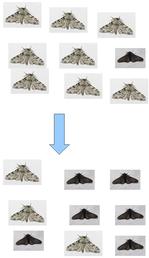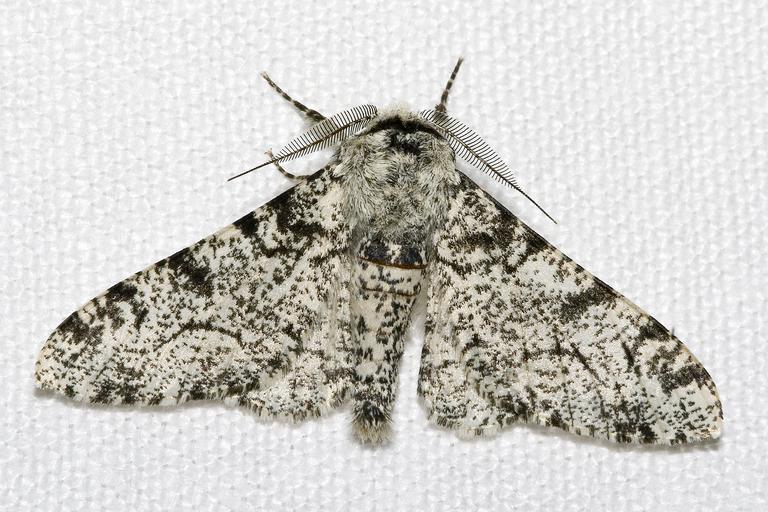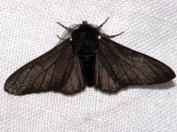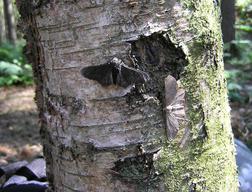 | ||||
Role of Genetic Mutation In Evolution - P2
SPO VIRTUAL CLASSROOMS
Page last updated: 11/2015
You have FREE access to a large collection of materials used in a college-level introductory biology course. The Virtual Biology Classroom provides a wide range of free educational resources including PowerPoint Lectures, Study Guides, Review Questions & Practice Test Questions.
Natural Selection Example: The Peppered Moth
The peppered moth (Biston betularia) is a temperate nocturnal moth species that provides a great example of natural selection. In England, prior to the inductrial revolution, the common color of peppered moths was light gray (Biston betularia f. typica). The moth’s light gray color closely matched the lichen-covered trees in their environment, providing them with camouflage from predators, such as birds.
Population shift in Color of Peppered Moths
After the industrial revolution trees became darker from the pollution and dark moths were selected for.
Mock-up illustrating peppered moth evolution based on pictures taken by Olaf Leillinger.
PAGE 2 < Back to Page 1
End of Article
There was also a mutated color variant in the moth population that resulted in some, relatively rare, very dark colored moths (Biston betularia f. carbonaria). Their numbers remained low because when these dark moths landed on the light grey lichen-covered tress, they were easy targets for predators.
When the light-colored peppered moths landed on the same trees they had always landed on, they were extremely visible against the dark bark, and easy targets for predators. The dark colored moth variant now had the advantage, being harder for predators to spot and more often living long enough to reproduce.
Over generations, the polluted environment continued to favor darker moths, and they progressively became more common. By the late 19th century, 98% of the moths near cities were black.
But the industrial revolution changed the environment in a way that impacted these two peppered moth variants, and changed the population. Early coal-based industry was extremely dirty, and around large cities, everything was essentially covered in soot. This high level of pollution killed the light gray lichens on trees and the bark became much darker in appearance.
Typica and carbonaria morphs on the same tree. The light-coloured typica (below the bark's scar) is nearly invisible on this pollution-free tree, camouflaging it from predators.
Modern air pollution controls have since significantly cleaned up the environment. The cleaner environment has allowed the lichens to grown back, and the trees have returned to a lighter in color. Now, natural selection favors lighter moth varieties so they have become the most common and the dark-colored variant is again rare.
 | ||||||
SPO is a FREE science education website. Donations are key in helping us provide this resource with fewer ads.
Please help!
(This donation link uses PayPal on a secure connection.)
Sources & Resources
- Brown, Bryson (2007) Evolution: A Historical Perspective. Greenwood Press.
- Campbell & Reece (2005) Biology, 7th Edition. Pearson.
- Understanding Evolution website from University of California Museum of Paleontology.
- Evolution website from PBS.
- Fun Interactive Evolution Activity from the BBC's GCSE Bitesize.
- New NOVA Evolution website from PBS.
- Interactive Evolution Timeline from John Kyrk.
- Pre-Darwinian Evolutionary Theory, "Class Notes" from SPO.
- Charles Darwin and Evolutionary Theory, "Class Notes" from ScienceProfOnline.
- Evolution & Natural Selection, "Class Notes" from SPO.
- Is Evolution Just a Theory?, "Class Notes" from SPO.
- Evolution: Natural and Artificial Selection, "Class Notes" from SPO.
- "Darwinvaganza" Radiolab episode from WNYC.
- Charles Darwin Biography episode.
- Voyage of the Beagle, by Charles Darwin. Audio reading from LibriVox.
- "In Defense of Darwin" Radiolab episode featuring Richard Dawkins.





